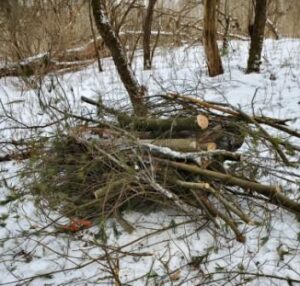The snow storm of 4/18/2022 caused a lot of power outages in this area. Urban places that don’t normally lose power were without power for almost a week. My own area of responsibility was hit hard and it was not until 5 days after the storm that the last area I was responsible for went off generator power.
In the grand scheme of things, this was not a big deal. Most of the rest of the state was not impacted so resources poured in to fix things. The weather was not super cold. Needed resources could be found if you went a little out of your way. Nonetheless, I think there were lessons learned that while not critical for this emergency, it could make more of a difference if things had been more serious. My list of lessons learned is as follows….
1. Carry a flashlight: It is what I needed to go to the bathroom in the mostly office complex I was working in. We did not have lights in the bathrooms for almost a week (we were on emergency power) but the water all worked fine. Other people used their cell phones but I could not find a way to use a cell phone in a bathroom in way that I was comfortable with where as with a flashlight I could set it down on a counter or garbage can or like surface and it threw off enough ambient light for my needs.
2. Carry a power bank for phones: I was on my cell phone non-stop the first few working days after the storm without a lot of options for recharging it. I had to use my power bank to keep my phone going and one of my co-workers (He was not using the phone as much as me but I suspect his reason for needing a recharge had to do with using it as a flashlight all the time. That is why it is good to have a flashlight even if you are happy with the light that your cell phone throws off.). I have noticed that in Ukraine in the cites under attacked everyone is going stations set up by that countries emergency services to get drinking water, food, and to charge their phones. It is interesting that cell phones retain their utility even in warzones.
3. Carry a good light weight hand saw in the car: I had my Silky Saw with me when I went in the first day when all the trees where down. I did not need to use it because I was driving my off road capable truck and so just went into the drainage ditches a few times to get around trees. But if I had been driving my car, I would have needed the saw to take out the smaller branches on the tops of trees to create enough space for my car to get through. A hand saw will not be enough to get through big tree trunks but all the trees I saw down that day could have been passed by a car with AWD if you cut the smaller branches off the top.
4. Don’t freak out when your generator stops working: In my area of reasonability I had eight generators stop working on me at various points during the extended area of responsibility. Most of these were Generacs. Of all of them that went down, only two of them were what I would consider real issues (a leak in the coolant reservoir and low oil with metal shavings in the oil). All of the rest were a sensor issues. Most of the sensor issues were fixed simply by resetting the generator and they ran fine for all the rest of the power outage (one of the non-Generac generators kept going down periodically with a sensor failure but started right up again after every reset). Even the generator down on coolant was fixed without parts (the tank was rigged up in a way to keep it from leaking) and so was the one low on oil (put more oil in and it ran for the rest of the power outage). Bottom line is if has got fuel, oil, and coolant, give it another shot before you assume you are doomed.
5. Make sure you have emergency food that does not require heat or refrigeration in your car: There was no power for cooking or refrigeration at the worksite and the restaurants were not working the first day either. Mountain House granola has freeze dried milk in it. Add water and it is like bowel of cereal. Not a lot of calories but better than nothing on a stressful day.
6. Cell tower generators seem to be able to last on the upper range of what I believed to be possible: Long before this storm I took a survey of our local cell tower to see what kind of emergency backup they had. In my notes at the time I wrote about a particular carrier’s generator at that site “Tag on generator says it has 54 gallons of fuel on board. If this is true, it will put it right around the 48 hour mark.” Elsewhere I wrote “current estimate is the local towers will only last 24 to 48 hours.” These estimates were based on a combo of knowing the federal regs and looking up the fuel consumption rates of generators that I saw on the local tower. I am not sure exactly when the power came back on but they lasted more than 24 hours for sure. The local cell service did go down for a little while on the morning of the second day but that seemed to be an area wide thing. I wonder if they shut things down at what they perceived to be a low usage time to extend run times or if it was some other issue not related to lack of power that caused the mobile networks to go down?
7. Putting off stuff you know you will need in an emergency can come back to haunt you: I had two things on my list of things to do because I knew I would regret not doing them if an emergency came. One was get the generator working at my brother’s house. Another was get the software token working that allows me to work remotely. In spite of knowing about these issues for at least a couple of weeks before the storm, I did not have them taken care of by the time that storm came around. In the end it was not a big deal. We were able to get the generator running (another sensor issue) and since most of my work was on the phone the first couple of days I was able to operate without a token until I was able to get on my employers intranet and fix my token issue. Still, both of those things could have been a more serious issue if the emergency had been worse.
8. Getting a propane tank filled in a timely manner can be tough in even a mild emergency: We were in the red on our tank when we got a refill and it took some begging to accomplish that. As it turns out, the power came back on just before we got the refill so it was not all that critical in the end. Still, if we had run out I would have felt like a fool for not turning the propane powered generator off at night to extend our supply. My planning document for an ice storm had just that plan for when roads were blocked with down trees, but I figured once the roads were clear nothing would prevent the propane trucks from coming. That was more or less the case but it was a closer run thing then I would have liked. There was a backup plan for heat, water, and lighting but the cooking plan for a no propane situation was not well developed. Also, there was a lot of food in the freezers that would have gone bad if the issue had lasted long enough. This issue was not limited to my personal location. Generators at work took some government persuasion to be filled in a timely matter. Bottom line: You should not assume you are getting fuel just because the roads are clear even if it is not an end of the world type emergency.
9. Urban areas don’t always recover first: In my FEMA plan for Rural Folk I said that if urban areas were without power for two weeks, rural areas would be without power for a month. That statement seemed like a combination of common sense and extrapolation from historical events. But the biggest surprise I had during this storm is that many rural areas had their power restored before some of the urban areas did. Rumor had it is that this was in part due to difficulty getting transformers but it was also rumored that the local power company was having difficulty coordinating crews effectively. Regardless of the reason, it was a pleasant surprise to have power restored at home before either my main place of work or many of my more urban co-workers had their power restored. I guess the main lesson is don’t expect that you will be all right in short order when this stuff happens just because you live in an urban area.
And that is all I can think of that I can honestly say were lessons learned based on the this storm. Do any of you have anything to add?




